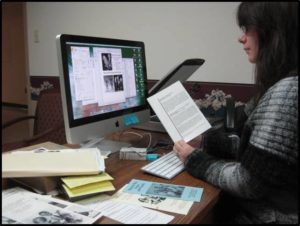IN THE ARCHIVES, PART I, BY DARCY HOLTGRAVE
Welcome back to Stories from the Field at our Show-Me Folk blog. The blog is our dedicated space for staff, student workers, traditional artists, cultural experts, consultants, and community scholars to share photo essays on an array of topics in Missouri’s traditional arts and folklife.
Please welcome our latest guest blogger, folklorist Darcy Holtgrave, PhD, who has played many roles at the Missouri Folk Arts Program over almost a decade, from graduate student intern and graduate assistant to consultant, evaluator, and panelist. We at MFAP have been beholden to Dr. Holtgrave over the years for many tasks and projects. These days, Dr. Holtgrave is an academic adviser in Mizzou’s Honors College. We consider ourselves lucky that she is available for the occasional consultancy. In her two-part post, she shares stories about her roles and responsibilities over the years with regard to our archival materials. If you enjoy her post, please like it here and share with others.
In the Archives, Part I
by Darcy Holtgrave, PhD
When I was Missouri Folk Arts Program’s graduate intern in 2010, I was thrilled to be assigned to dig through their archives for materials for an exhibit. My delight will make more sense if I tell you something about myself: I am an accumulator. Calling myself a “collector” would be misleading because that would imply a master plan; simply put, if it’s interesting and might be useful someday (particularly for crafting), I want to keep it, like the 6-foot wide roll of gold velvet I found at Goodwill or my rapidly-growing collection of empty glass spice shakers. The word “hoarder” is now connected with mental illness. The word’s ancient definition (and yes, I’m going to do that thing that I tell my college composition students NOT to do, which is to use a dictionary definition in an essay, but this is really interesting), according to the Oxford English Dictionary, is more of a job title: “The keeper of the hoard or treasure; a treasurer; a steward.”

Me when I see something that may useful one day.
So being set to work in that ultimate curated accumulation of stuff, The Archive, excited me. MFAP’s work generates a substantial amount of stuff of historical interest, seeing as how its mission is “build[ing] cross-cultural understanding by documenting, sustaining, and presenting our state’s living folk arts and folklife in collaboration with Missouri’s citizens.” Documenting a master/apprentice team of traditional artists as part of MFAP’s Traditional Arts Apprenticeship Program (TAAP), for instance, creates several forms of media. In Spring 2016, now working as an outside consultant, I documented the work of master leather carver Mike Massey and his apprentice Mike Noonan. I took about 70 pictures, recorded maybe two hours of audio and a couple of brief videos (which didn’t turn out), and tried my own hand at leather carving, making a key fob. After the visit, I wrote a report, which I submitted with choice photographs.

The key fob I made under Mike Massey’s tutelage
Items like these (minus the key fob, which is on my keychain), start out in MFAP’s working archives, which are immediately accessible to the staff in the office. Largely digital, they exist on servers where staff can find, say, a recording of old-time fiddler John Williams to add to a grant proposal or an image of storyteller Gladys Coggswell to illustrate a flyer for an upcoming event. Having digital archives adds a layer of welcome convenience and dangerous ephemerality to the exercise. Once in the MFAP office, as graduate intern, I was copying images onto an external hard drive that had to be plugged into a power outlet and the computer. I had arranged the various cords stupidly as a tripwire trap in my walkway. When I inevitably got up, forgot the cord, and kicked the drive to the floor (and my eyes met with Director Lisa Higgins’ across the office in utter horror), the material on it was lost; luckily, most of it was already backed up on the server. MFAP’s working archives also consist, to an extent, of physical files, like paper applications for TAAP and flyers for events.
Most of the literal bulk of MFAP’s archives, however, exists off site, housed at the State Historical Society of Missouri. This is a matter of practicality, preservation, and public access. When the Missouri Folk Arts Program was established in 1984, first under the auspices of the Missouri Cultural Heritage Center, its mission of documenting and promoting the folk arts was largely the same, but the collection technology was different. Two hours’ worth of audio recording that now fits (along with hours more) on a 1” square SD card took up two 3 x 5” plastic audio cassettes then. Imagine how many cassettes that meant in documenting around 10 master/apprenticeships per year for 10 years. Add in miscellany like special events and a few professionally-recorded cassettes, and the State Historical Society currently holds 2132 cassettes in the MFAP collection. Plus 65 audio tapes (those big reel-to-reel deals) and 32 video cassettes, and exactly 1000 file folders with papers, photographs, slides, and negatives. The sheer volume of material is a lot for a small office with two full-time staff and graduate student workers to maintain and store.

Then-graduate student worker Alison Balaskovits scanning and digitizing documents for the archives
As an example, in 2004, MFAP moved offices from McReynolds Hall to basement offices at Parker Hall, which was built in 1889 and not the most ideal location for climate-controlled storage. MFAP donated the physical records from 1983 to 2000 to the Western Historical Manuscripts Collection, which is now part of the State Historical Society of Missouri. There, the materials underwent a preliminary inventory and were transferred to storage, where they awaited further processing but were available to a public who could order materials for viewing in a supervised reading room.
Space is finite, though, even for a professional state archive. Or maybe I should say especially with them, who are tasked with maintaining archives of interest to people from family genealogists to academic historians to playwrights throughout the entire state. In my personal collection, I hit a breaking point this winter when I opened my craft closet door and was ambushed by that roll of gold velvet, along with a pile of old jeans I had precariously stacked on top of all the bins of other fabrics awaiting a project.
So I had to ask myself that awful question: What’s worth keeping? And why? Stay tuned for Part II and musings on this question, as applied to my collection and the folk arts collection too!
